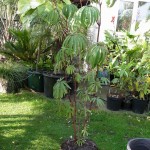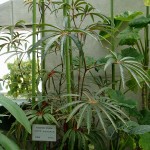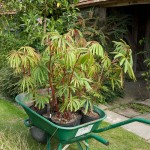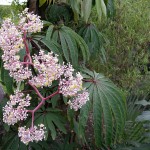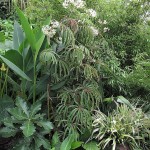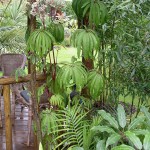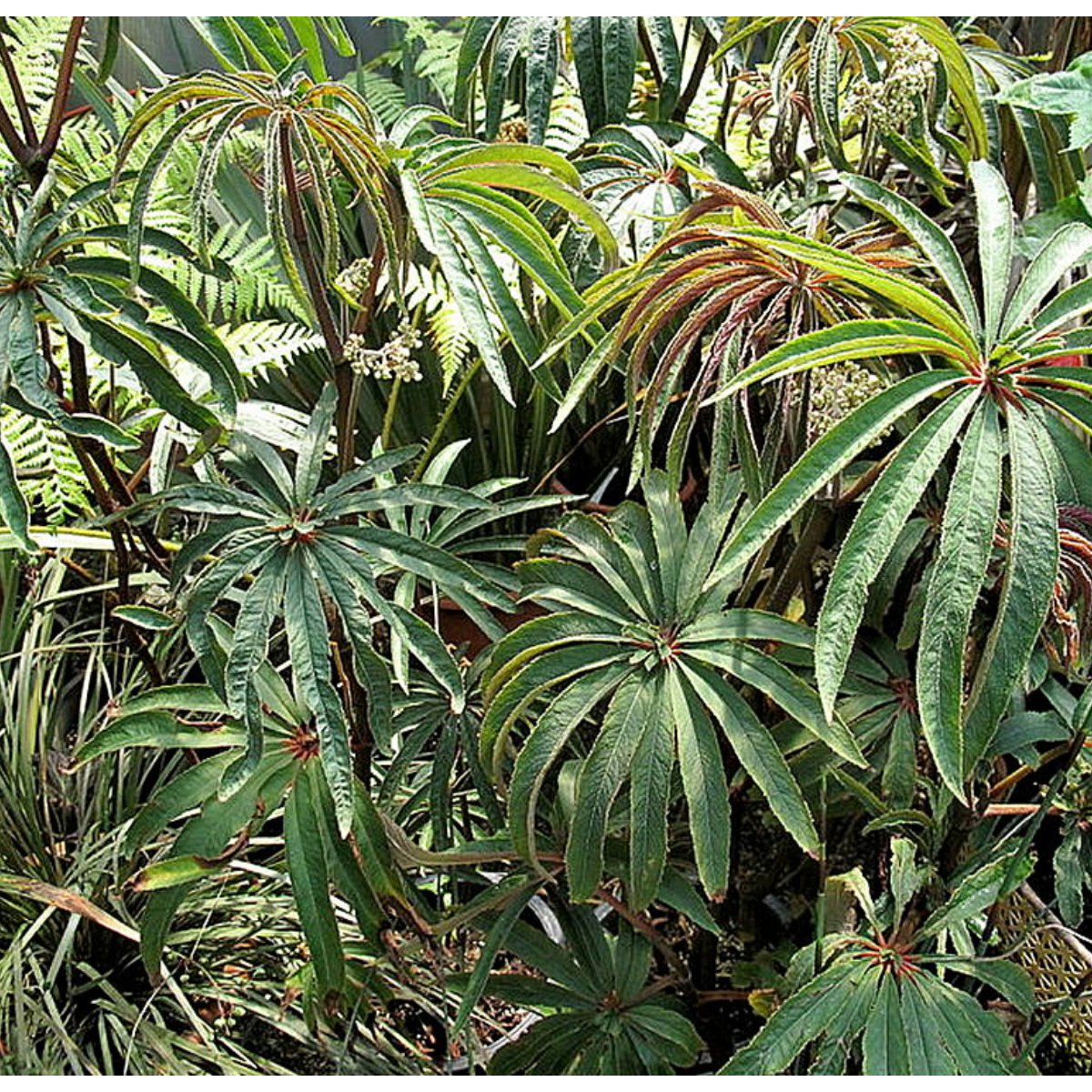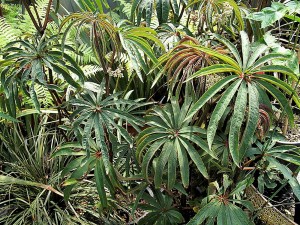Family: Begoniaceae
Synonymous: Begonia luxurians var. sampaioana
Scheidweileria luxurians
Distribution and habitat: Begonia luxurians is an unusual species from the rain forests of Brazil that looks more like a palm tree than a Begonia. It is a tall shrubby cane-like begonias growing up to 4m (13 feet) tall over a few years. Its natural habitat would be in humid, semi shady locations. Although it is grown primarily for its highly decorative foliage it does bear pretty flowers, which are quite fragrant by all accounts.
Description: Begonia luxurians is an erect woody herb with purple stems.This robust, upright-growing species can grow 2.5 to 4m (8-13 feet) tall. The stems are hairy when young and become hairless with age. The leaves have 7-18 palmate lobes and hairy stalks. The lobes are lanceolate, acute, sharpy toothed, hairless. The stipules are lanceolate, acuminate and hairless. Large cymens carries pink flowers. The bracts are lanceolate. This plant has many male flowers and only few female flower. The male flowers has four perianth-segments, obovate and the outer surfaces are rough or hairy. These flowers are filaments free. The female flowers have five perianth-segments and are oblong and hairless with undivided placentae. The flagrant flower clusters appear from late winter into summer at the tops of the branches. The fruits are three celled capsule, about 6.7-9mm. They are hairy and equally three winged.
Houseplant care: Begonia luxurians is seldom flowering indoors. It is a large-leafed shrub-type growing 2.5m (8 feet) tall indoors, although it may be pruned to any size.
Light: Begonia luxurians plant enjoys filtered light but can take some sun in winter.
Plants grown under natural sunlight on a window side will often perform best when provided with a south facing position in winter and est-facing one in summer.
Temperature: Normal room temperatures are suitable for actively growing plants. Overwinter these plants at no less than 10C (50F).
They will suffer in dry air. Over about 50% humidity is best for these plants. For increased humidity stand pots on trays of moist pebbles.
Watering: Water actively growing Begonia luxurians plants moderately, allowing the top couple centimetres (0.8 inch) of the potting mixture to dry out before watering again. During the winter rest period water more sparingly, allowing the top half of the potting mixture to dry out between waterings. It is recommended to use lukewarm water when watering these plants.
Feeding: Apply standard liquid fertiliser every two weeks to actively growing Begonia luxurians plants. Do not apply fertiliser to newly repotted plants for about one month.
Also remember that a soilless potting mixture will need more frequent fertiliser applications than most soil based potting mixtures.
Potting and repotting: Use either a peat-based mixture or a combination of equal parts of soil based potting mixture and coarse leaf mould. Place a shallow layer of clay-pot fragments in the bottom of pots for extra drainage.
Move the plants into pots one size larger every spring until maximum convenient pot size has been reached probably 15-20cm (6-8 inch) . Thereafter, top-dress annually with fresh potting mixture.
When potting and repotting these plants, simply sprinkle some mixture around the roots and tap the container briskly to settle the mixture. Do not firm it down with the fingers.
These plants are top heavy, so it is recommended to use heavy clay pots.
Gardening: Begonia luxurians is a very ornamental foliage plant very popular in cultivation. The species is readily grown in a greenhouse or - in suitably warm areas - the outdoor garden.
Begonia luxurians might be able to survive a light, brief frost, but it is strongly recommend keeping it above 2C (36F). Although extremely hot temperatures might stress this plant. Excess sun and wind cause flowers and leaves to dry up and the tropical luxuriance of the plant is diminished.
Position: Begonia luxurians requires bright filtered to part sun situation, but avoiding the mid-day sun. It enjoys dappled sunlight or bright shade. Protect it from strong sun exposure and winds.
Soil: Begonia luxurians prefer a free draining soil that tends towards being more acidic with a pH of around 5.5 to 6.5. It does not like soggy soil though, so in heavy-rainfall areas, use a looser soil mix.
Use leaves to form a thick natural mulch layer around the plants that holds in the moisture and also breaks down to enrich the garden soil.
Irrigation: In the garden, water them deeply as required. They are succulent plants so they will accept quite dry conditions. Allow the soil to dry thoroughly before watering again. Do not to overwater these plants.
Water pot-grown Begonia luxurians when the soil surface dries out test with fingertip to 2cm (0.8 inch) depth. When water the plant ensure that the pot is saturated, but do not allow them to stand in water.
Fertiliser: Add controlled-release fertiliser to the planting hole and apply a good general-purpose liquid fertiliser once a month.
Propagation: Begonia luxurians are best propagated via stem cuttings taken from near the base of the plant or by seed.
Stem cuttings propagation: Take a 8-10cm (3-4 inch) long cuttings of stem, best taken from near the base of the plant in spring or early summer. Trim each cutting immediately bellow a leaf, carefully remove the leaf and dip the base cut end of the stem in hormone rooting powder. Plant the cutting in a 8cm (3 inch) pot of a moistened equal-parts mixture of peat moss and coarse sand or perlite and enclose the whole in a plastic bag or propagating case. Stand it in bright filtered light until renewed growth indicates that rooting has occurred. It will take about three to six weeks to root, less in case it is used the basal part of the steam. Uncover the rooted cutting and begin to water it sparingly and to apply standard liquid fertiliser about once every two weeks. Do not overwater to avoid rotting. About six months after the start of propagation, move the young plant into a slightly larger pot of standard potting mixture and treat it as a mature plant.
Propagation from seed: seeds are very tiny and should be not buried when sown. Mix them with little fine sand before sowing. Sow seeds trays in any standard germination medium (equal parts of peat and perlite or equal parts of vermiculite and perlite). A light mist spray of the surface will settle the seeds adequately. Keep the propagating trays in warm, moist conditions (intermittent mist ideal) in bright light, but no direct sun.
Prick the seedlings out into individual cells or small pots 6-8cm (2.5-3inch) when the first three leaves are formed. Use same potting mixture as for mature plants. The seedlings benefit from dilute applications of soluble fertiliser every two weeks. Re-potting will be necessary in about six months or so. Pot the new plants in pots one size larger when the root ball fill the pot. Thereafter treat them as mature Begonia luxurians.
Problems:
Mealy bug can be a common pest of Begonia caroliniifolia plants.
Treatment: If infestation is localized, remove insects by wiping affected areas with a cotton swab dipped in rubbing alcohol or dipping the plant in a solution of soapy water and alcohol.
A number of tiny mite species can be problematic for Begonia caroliniifolia. Infested leaves are yellow speckled and, if the infection is severe, may be covered with wool like substance on their undersurface.
Treatment: Control these mites with a suitable acaricide.
There are two kinds of microscopic, worm-like creatures parasite to Begonia caroliniifolia plants: leaf nematodes and root nematodes.
Treatment: The best form to control is to destroy affected plants. In open garden avoid replanting begonias in contaminated soil. In case of potted plants, infestation may be prevented ans controlled by routinely using sterilized potting mixtures and washing the plant pots.
Scale insects may feed on Begonia caroliniifolia plants.
Treatment: If infestation is localized, remove insects by wiping affected areas with a cotton swab dipped in rubbing alcohol or dipping the plant in a solution of soapy water and alcohol.
Slags and snails are a problem in open garden.
Treatment: These pests are controlled using an appropriate molluscicide, both pellet and liquid forms or by hand pick at regular inspections.
Both the adults ans larvae of two kinds of weevils feed on Begonia caroliniifolia.
Treatment: Insecticides are capable of controlling these insects, but if they are inside the cavities of the plants, they will not be killed. To fully exterminate them, systemic insecticide are needed.
Whiteflies infest the under-surface of the uppermost leaves and if disturbed fly rapidly around the top of the host plants.
Treatment: Successive sprays of insecticidal soaps or white oil will eradicate whiteflies infestations. Coverage of leaf undersides is important.
Bacterial leaf spot will produce water-soaked areas on the leaves that are surrounded by yellow rings. It may cause leaf drop and, in some cases, associated stem rot may occur.
Treatment: Once the disease is present, remove and destroy any affected leaves or stems and spray the plants with a bacterial leaf spot treatment.
Botrytis blight will produce gray moldy patches on leaves, stems and duds.
Treatment: This disease can be managed by improving the air circulation and plant hygiene by removing and destroying dead and dying leaves ans flowers. Use a suitable fungicide.
Powdery mildews produce unsightly white powdery patches on leaves, stems and buds.
Treatment: Manage this disease by restricting watering to morning so that water unwillingly splashed on leaves will quickly evaporate. Improve the air circulation around the plants. Severe cases may be treated with adequate fungicide.
Pythium rot root attacks the roots and stem bases of adult plants and cuttings. Affected plants at first will have a slightly wilted appearance, followed by yellowing their lower leaves. As the disease progress, the roots and stems turn black and musky, leading to the death of the plant.
Treatment: The use of sterilized potting mixture and use of appropriate fungicide will control this disease.
Rhizoctonia crown rot will be detected by the presents of brownish mould spreading from the soil to the infected stem base, a condition that will eventually lead to the collapse and death of the stem. This fungal disease appear only on plants that have been damaged or stressed by high temperatures or poor growing conditions.
Treatment: Maintenance of hygienic conditions and good cultural practice should prevent fungal growth. Fungicide sprays are also available.
A variety of viral diseases can attack Begonia caroliniifolia plants causing symptoms like yellowing the leaves, pale yellow rings or spots, leaf malformation and stunted growth.
Treatment: Always use sterile potting mixture and treat insect infestations to prevent viral disease. Destroy all affected plants.
Companion plants: Begonia luxurians associates well with other shade loving foliage plants such as ferns. It grows in the shade of larger plants such as bananas, tall grasses and palm trees.
Uses and display: While the flowers are certainly pretty, the real excitement of Begonia luxurians plants is its highly decorative foliage. The fan-like leaves emerge in an alternating, zig-zag pattern from each stem, for a great tropical look. It grows well indoors in a pot, and may even be raised as a bonsai specimen. It can be used as a tender perennial in a planter, where it can be grown to great effect alongside a palmate-leaved palm.
SUMMARY:
CHARACTERISTICS:
Foliage coloured
Features - flowers, fragrance
Shape bushy
Height: 2.5 to 4m (8-13 feet)
PROPER CARE:
Watering in rest period moderately
Watering in active growth period moderately
Light bight filtered
Temperature in rest period min 10oC max 16oC (50-60oF)
Temperature in active growth period min 16oC max 27oC (61-81oF)
Humidity moderate
Hardiness zone: 10a-11
